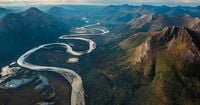On October 6, 2025, President Donald Trump signed an executive order that sent shockwaves from Washington to the remote valleys of Alaska’s Brooks Range. The order reverses a Biden administration decision, clearing the way for the controversial 211-mile Ambler Road—a project that has become a lightning rod for debates about economic growth, environmental stewardship, and Indigenous rights in the far north.
The proposed Ambler Road, developed by the Alaska Industrial Development and Export Authority (AIDEA), Alaska’s state-owned investment bank, would carve a gravel route from the Dalton Highway almost to Kotzebue, opening access to the mineral-rich Ambler Mining District. This region, as Interior Secretary Doug Burgum put it during Monday’s White House announcement, is “rich in all of the minerals that we need to win the AI arms race against China and to prosper as a country.” The minerals at stake—copper, cobalt, gold, zinc, gallium, and germanium—are critical for batteries, high-tech manufacturing, and national defense.
Trump’s move not only revives the road project but also signals a new era of federal involvement in Alaska’s mining sector. The administration announced a $35.6 million investment for a 10% stake in Trilogy Metals, a Canadian company exploring the Ambler district. This, according to Tony Giardini, president and CEO of Trilogy Metals, is “a significant milestone for the firm and for the development of a secure, domestic supply of critical minerals for America in Alaska.” The agreement also includes warrants to purchase an additional 7.5% of the company, further deepening U.S. interests in the region.
“It’s an economic gold mine, so to speak. I signed this years ago, and Biden unsigned it for me,” Trump told reporters at the White House, referencing his earlier approval of the project during his first term. The Biden administration had blocked the federal rights-of-way in 2024, citing a U.S. Bureau of Land Management (BLM) review that concluded any version of the road would “significantly and irrevocably” harm the environment and the tribal communities that depend on hunting and fishing in the area.
The legal and political back-and-forth has been dizzying. After the Biden administration’s rejection, AIDEA sued, invoking Section 1106 of the 1980 Alaska National Interest Lands Conservation Act, which allows the president to decide appeals directly. Trump’s order now restores a federal right-of-way grant issued in 2021 and directs the Interior Department and the U.S. Army Corps of Engineers to issue all necessary permits. But the legal battle is far from over—a lawsuit challenging the 2021 right-of-way grant remains open in U.S. District Court in Anchorage.
Supporters of the road, including Alaska Governor Mike Dunleavy and all three members of the state’s congressional delegation, hailed the decision as a win for economic development and national security. “This decision will unleash development opportunities, create new jobs for Alaskans and secure access to strategic minerals,” Dunleavy said in a statement. U.S. Rep. Nick Begich, R-Alaska, echoed the sentiment: “By advancing this access, we are creating new opportunities for Alaskans while strengthening America’s supply chain and reducing dependence on foreign adversaries for our critical mineral needs.” Senators Lisa Murkowski and Dan Sullivan also praised the move, emphasizing its potential to “unlock a world-class mining district, deliver quality-of-life benefits for communities in the region, and help grow Alaska’s economy.”
But for many in Alaska, particularly among Indigenous communities and environmental groups, the announcement was anything but welcome. The road’s path would cross more than 10 miles of land owned by Doyon Ltd. and over 20 miles owned by NANA Regional Corp.—two powerful Alaska Native regional corporations. Neither has officially endorsed the project. In fact, NANA ended its involvement in 2024, citing concerns about project management, and said its position “will only be reconsidered if and when our established criteria are satisfied, in consultation with shareholders, local communities, and other stakeholders.”
Sarah Obed, senior vice president of external affairs for Doyon, stated that Monday’s announcement was “not a surprise,” referencing an earlier executive order. NANA President and CEO John Lincoln expressed appreciation for the administration’s support of economic development but stopped short of supporting the road, reiterating that their position remains unchanged.
Opposition is fierce and organized. The Tanana Chiefs Conference, representing 39 Interior villages and 37 federally recognized tribes, condemned the decision as “a direct affront to the voices of Alaska Native people.” Chief/Chairman Brian Ridley said in a statement, “This decision is a direct affront to the voices of Alaska Native people,” and pledged continued resistance to the project. Environmental groups, too, are mobilizing. Bridget Psarianos, a senior staff attorney with Trustees for Alaska, said, “He’s wielding this presidential power like a cudgel, including to overturn decisions that his own agencies have made and provided good reasons for.”
Concerns center on the potential for irreversible harm to the region’s fragile ecosystems and the subsistence lifestyles of local communities. The road would cross 11 rivers, thousands of streams, and about 26 miles of Gates of the Arctic National Park and Preserve. “I don’t want the Ambler Road because it’s going to bring in too many outsiders during hunting season,” said Ricko DeWilde of Huslia. “And also it’s going to open up the land to development and destroy a lot of the habitat, as far as fish-spawning streams and caribou migrations.” The BLM’s 2024 assessment found that the project could pollute spawning grounds for salmon and other species vital to Alaska Natives.
Jim Adams, Alaska senior director for the National Parks Conservation Association, called Trump’s order “so atrocious, it’s nearly unbelievable.” He added, “Our resolve is only strengthened to continue to fight the Ambler mining road, alongside partners from across the country.” Frank Thompson, tribal chief of Evansville, an Alaska Native village at the foot of the Brooks Range, was blunt: “This is the last undeveloped place in North America.”
Even among local residents, opinions are mixed. Some see the potential for jobs and economic opportunity, while others fear the loss of traditional ways of life. Kaleb Froehlich, managing director of Ambler Metals, said the company is “committed to ensuring that local communities see real, lasting benefits from this road in the form of jobs, investment and opportunities for future generations.” He acknowledged that partnership with Alaska Native communities is essential, stating, “The future of any project in this region will be built not only on plans and permits, but on partnership and shared purpose.”
Despite the presidential order, the project faces a long road ahead—literally and figuratively. Legal challenges remain, environmental reviews may need to be redone, and the approval of key landowners is still pending. As the debate rages on, the fate of the Ambler Road stands as a test case for the balance between resource development, environmental protection, and Indigenous rights in America’s last frontier.






